Bio 225 - Exam 2 - Neuroanatomy
1/105
There's no tags or description
Looks like no tags are added yet.
Name | Mastery | Learn | Test | Matching | Spaced |
|---|
No study sessions yet.
106 Terms
Neurons are the ________ ____ of the nervous system
fundamental unit
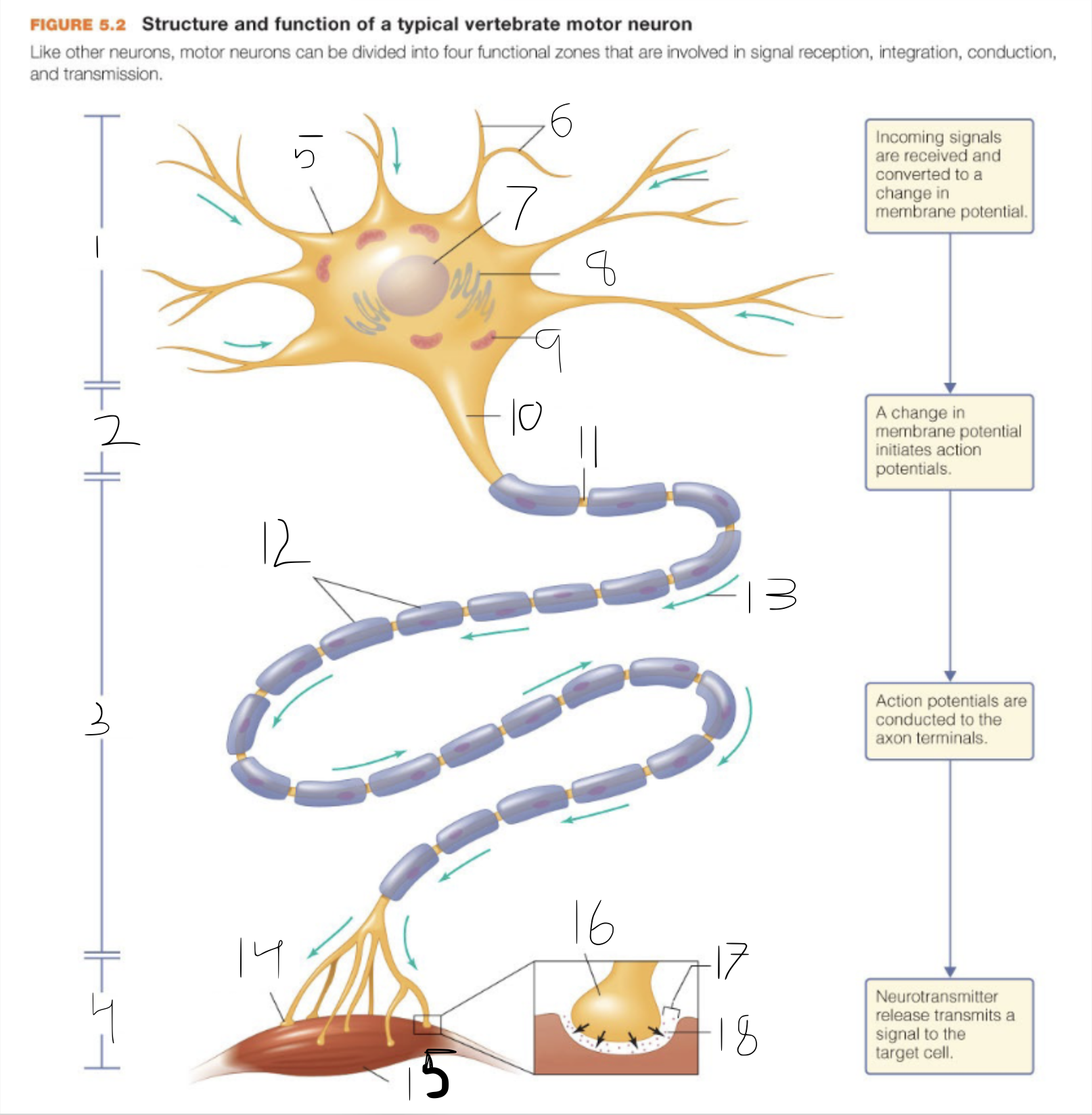
Label
1) signal reception 2) signal integration 3) signal conduction 4) signal transmission 5) soma (soma) 6) dendrites 7) nucleus 7.5) incoming signal 8) Endoplasmic reticulum 9) mitochondrion 10) axon hillock 11) axon 12) Schwann cells of the myelin sheath 13) direction of signal 14)axon terminal 15) muscle cell 16) axon terminal 17) synapse (neuromuscular junction) 18) neurotransmitter release
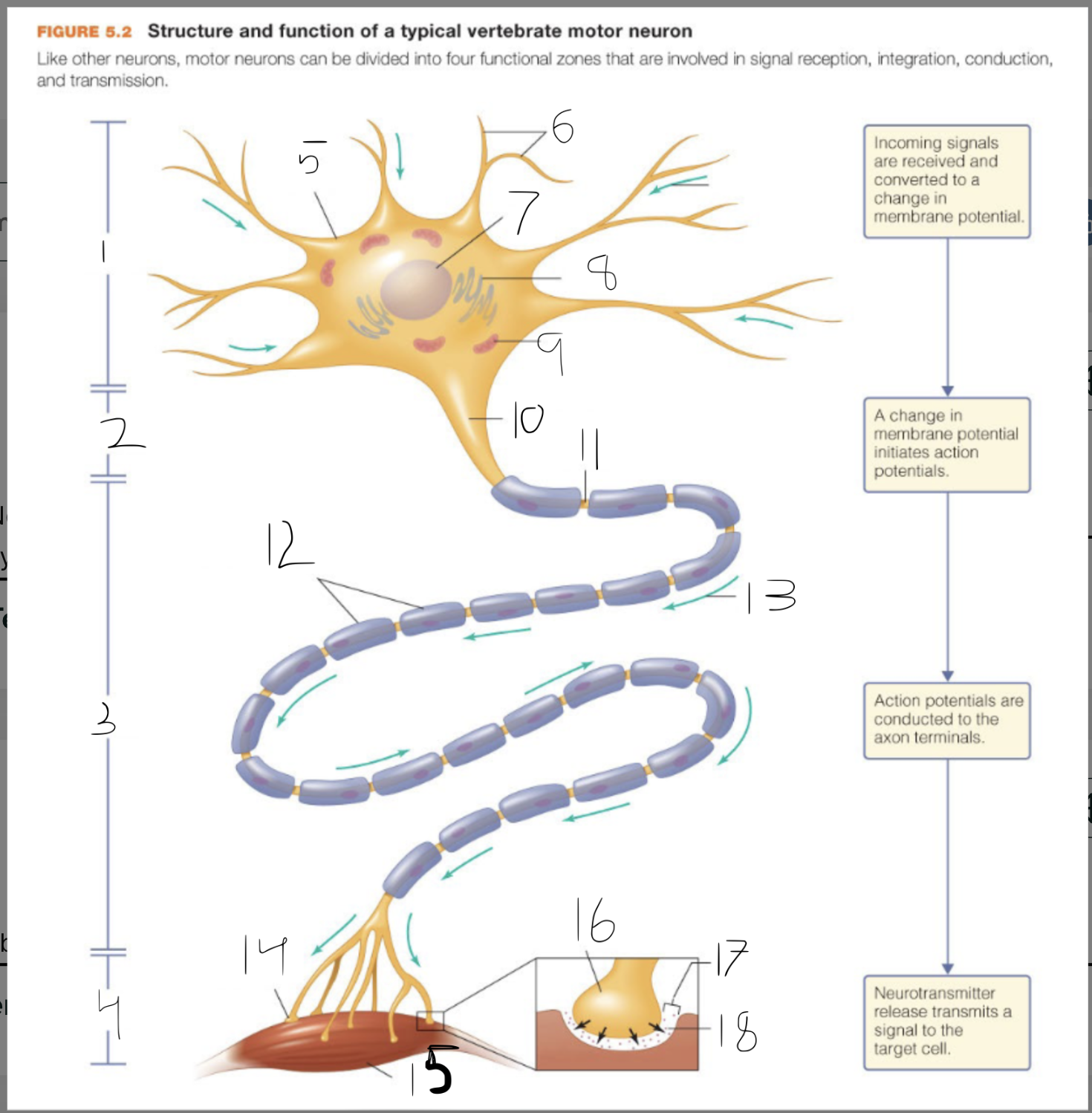
neurons are specialized to use _____ in membrane potential to________ _______ across ____ distances
changes; communicate signals; long
What kind of transport helps to develop a typical neurons membrane potential
primary active transport - Na+/K+ ATPase/Pump
electrical potential is
separated (opposite) charges have potential energy
Voltage difference across cell is defined as
charge difference from inside to outside of cell — inside cell is neg. compared to outside of cell beign pos.
Concentration of ions in cytoplasm v. extracellular and equilibrium potential
K+: high inside 400 mM and low outside 20 mM; -75 mV
Na+: low inside 50 mM and high outside 440 mM; +55 mV
Cl-: low inside 51 mM and high outside 560 mM: -60 mV
Organic Anions (A-): high inside 385 mM and none outside 0 mM
Ca2+: very low inside and low outside 1 mM: +130 mV
Membrane potential changes with ________ ______ of ____
selective movements; ions
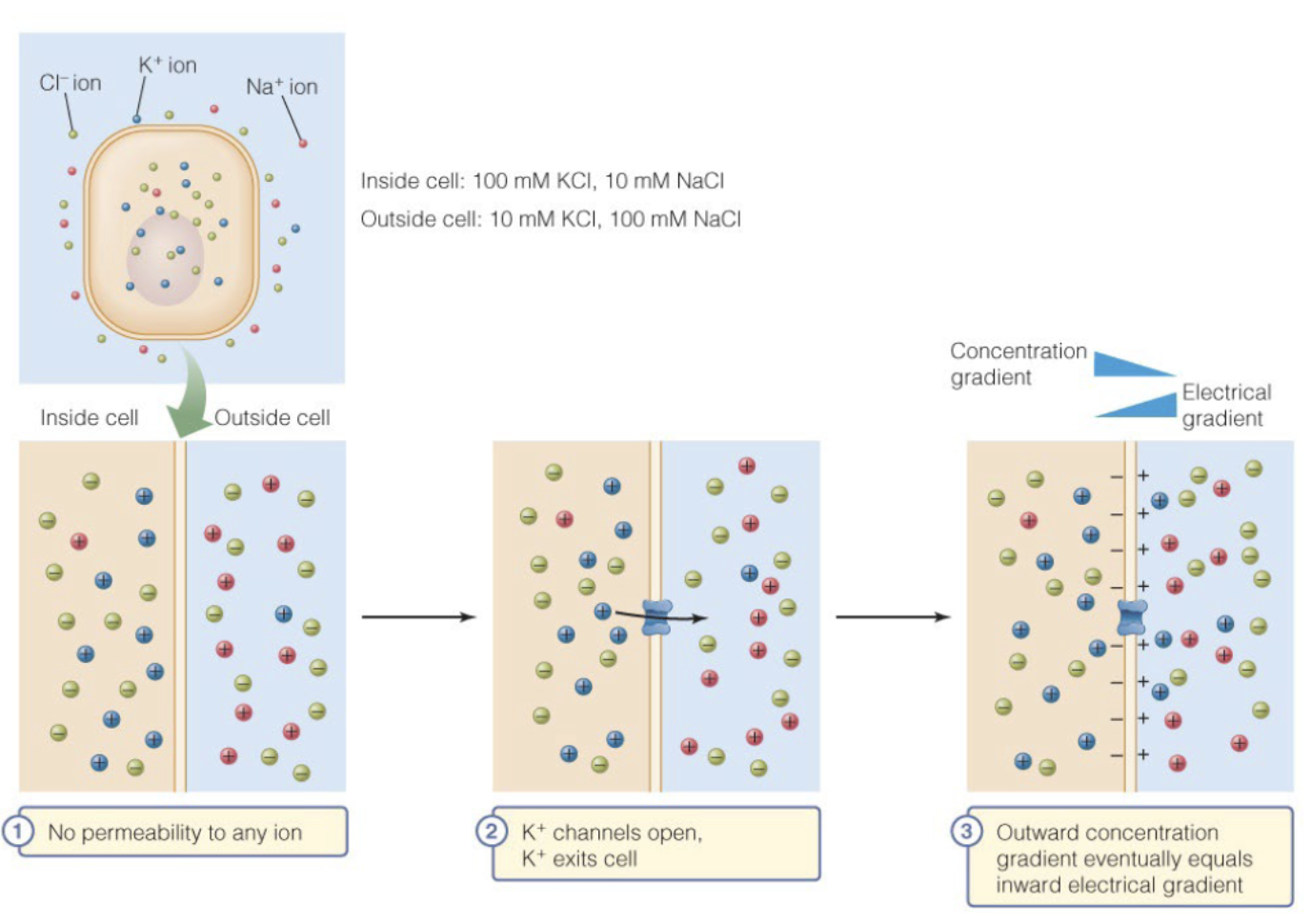
Equilibrium potential (Eion) is
aka:
The membrane potential at which the net flow of an ion is zero
aka reversal potential of an ion
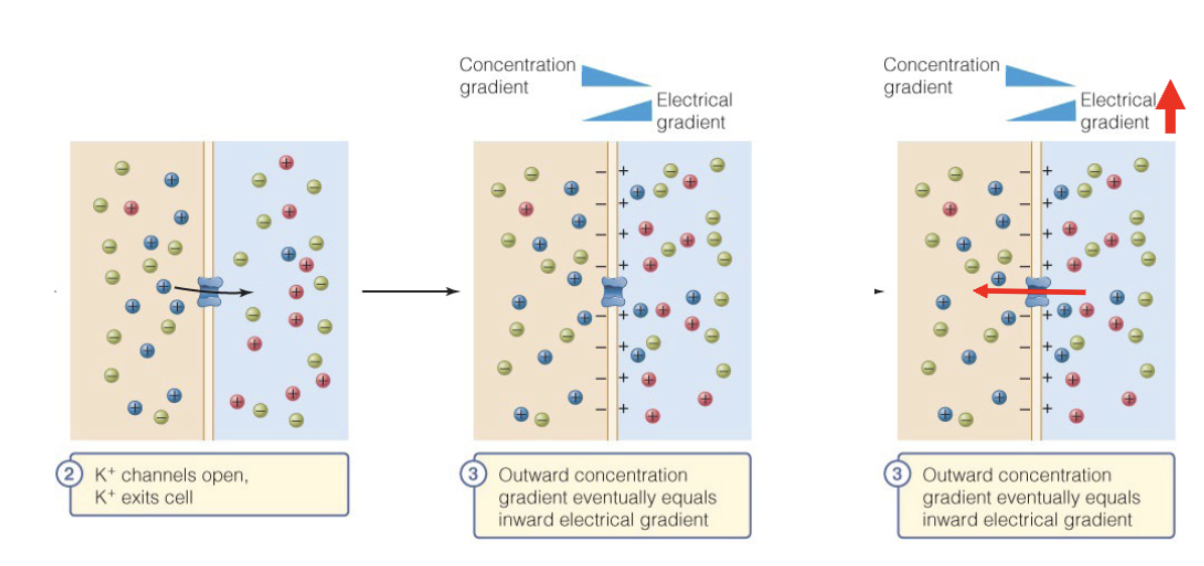
Equilibrium potential (E ion) can be
calculated using
Nernst Equation
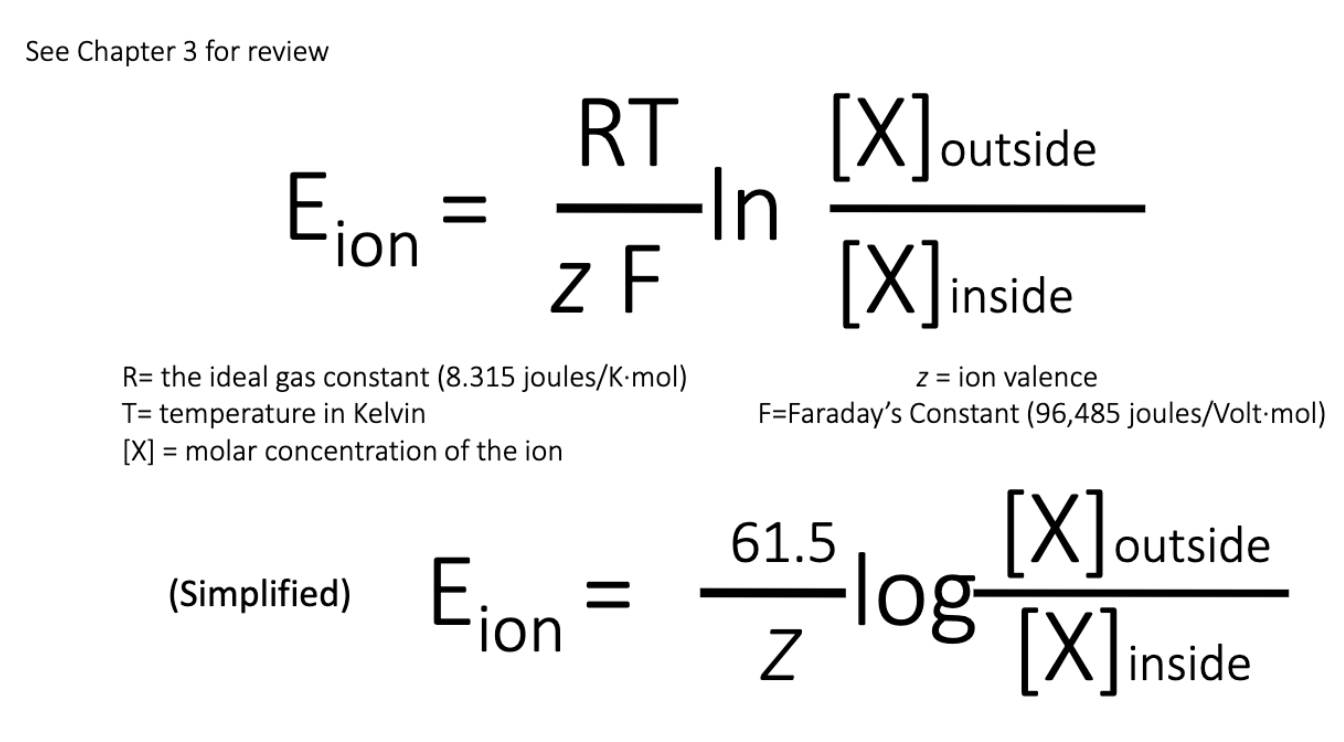
Equilibrium potentials can be used to
predict ion movements
Membrane potential is calculated using the
Goldman Equation - describes how membrane potential is determined by ionic concentration gradients and permeabilities
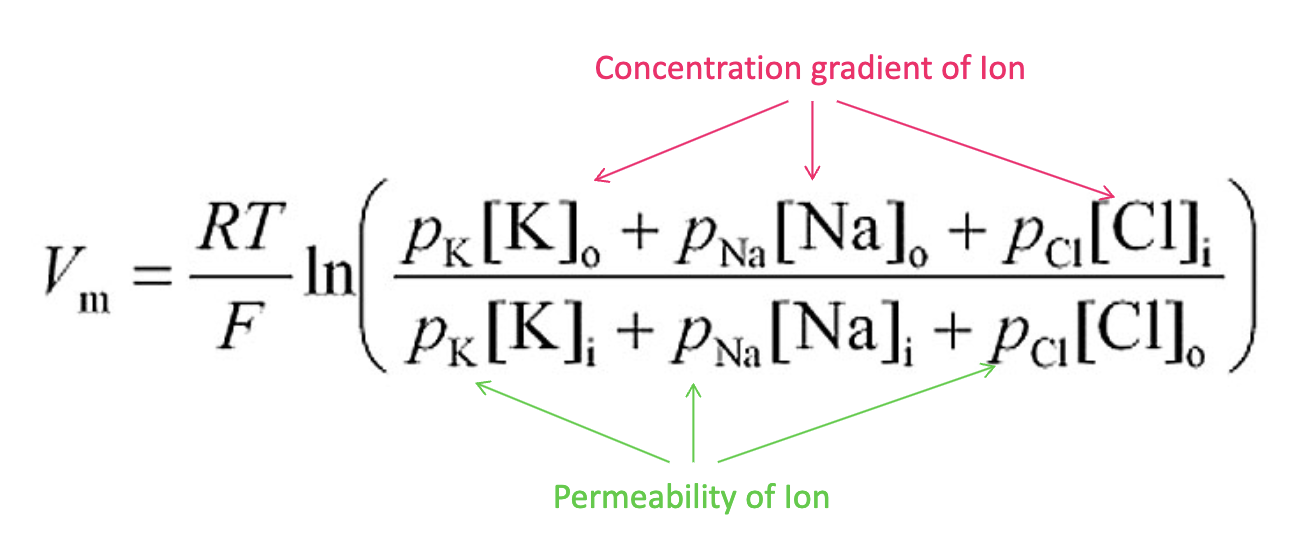
resting potential value for neurons
-70 mV
What factors establish/contribute to the resting membrane potential
ions: more (+) outside, more (-) inside
Na+/K+ Pump
Leaky channels: Na+ Channels and K+ channels
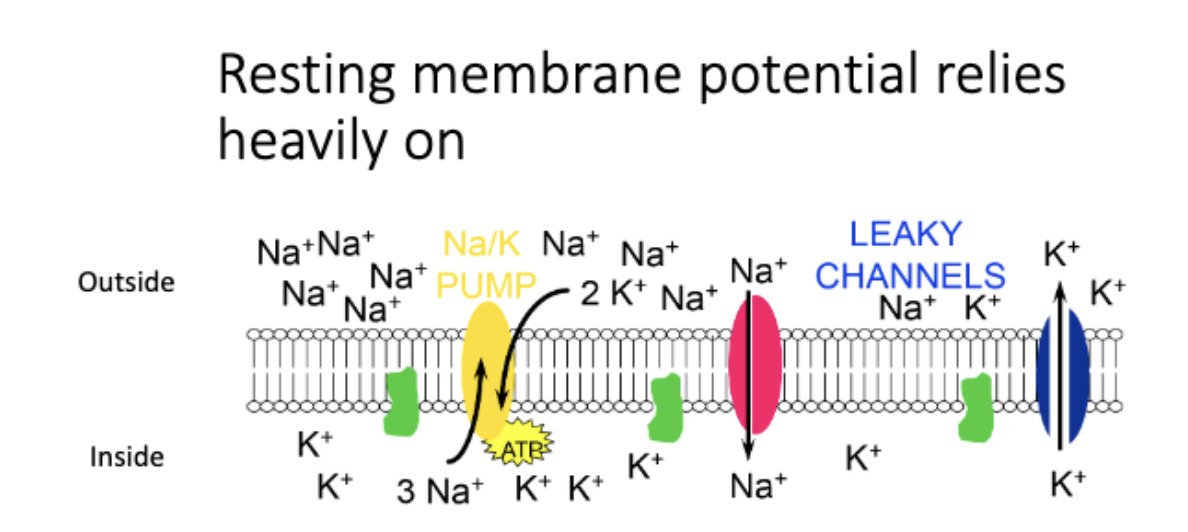
Equilibrium potential of main ions
K+: -75 mV
Na+: +55 mV
Cl-: -60 mV
How do neurons maintain concentraiton gradients
(active) transport
The resting membrane potential approaches (but does not reach)
Ek+
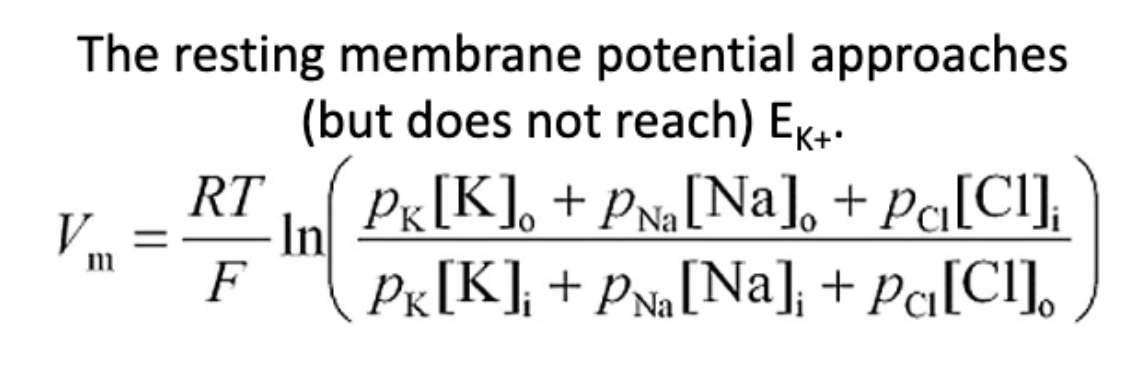
Rapid changes in membrane potential occur by
opening and closing ion channels
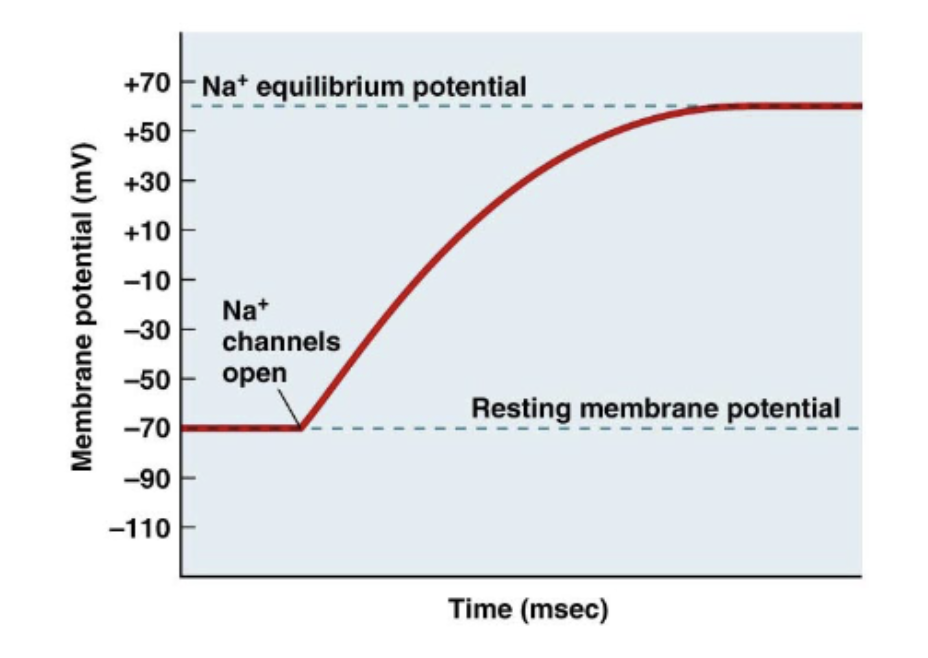
What governs ion flow
driving force
Driving force is
the difference b/w the membrane potential and the ion equilibrium potential
larger the difference, the stronger the driving force

Changes in potential are described relative to
the resting membrane potential: depolarization, repolarization, hyperpolarization
Local potential changes occur as
ions flow through the membrane
Depolarization
membrane potential becomes less negative
+ ions enter or - ions exit
Hyperpolarization
membrane potential becomes more negative
+ ions exit and - ions enter
net difference in electrical charge occurs at _______ surfaces of the ______
the inside and outside; membrane
large potential changes caused by…
minuscule ionic concentrations changes
rate of ion movement is proportional to
the difference b/w the membrane potential and the equilibrium potential (driving force)
What is the driving force
the net electrical force acting on an ion to move across a neuronal cell membrane
the difference between the actual membrane potential and an ion's equilibrium potential
integration area of neuron
axon hillock
where the decision is made
reception area of neuron
dendrites and soma
where messages are received (soma can receive messages)
conduction area of neuron
axon
conducts action potential
transmission area of neuron
axon terminal
electrical (ion transfer) or chemical synapse (releases neurotransmitters)
Resting membrane potential
at rest / -70 mV
created by Na+/K+ pump
maintained by (persists due) to leaky channels
Graded potentials
transient changes that occur locally
short distance signals - decay over short distances
vary in magnitude (proportional to the strength of the stimuli - not all or nothing) and duration
Action potentials
all-or-none
long distance signals (maintain amplitude)
same magnitude and duration for a given cell
occur in axons
caused by opening and closing of valtage-gated channels
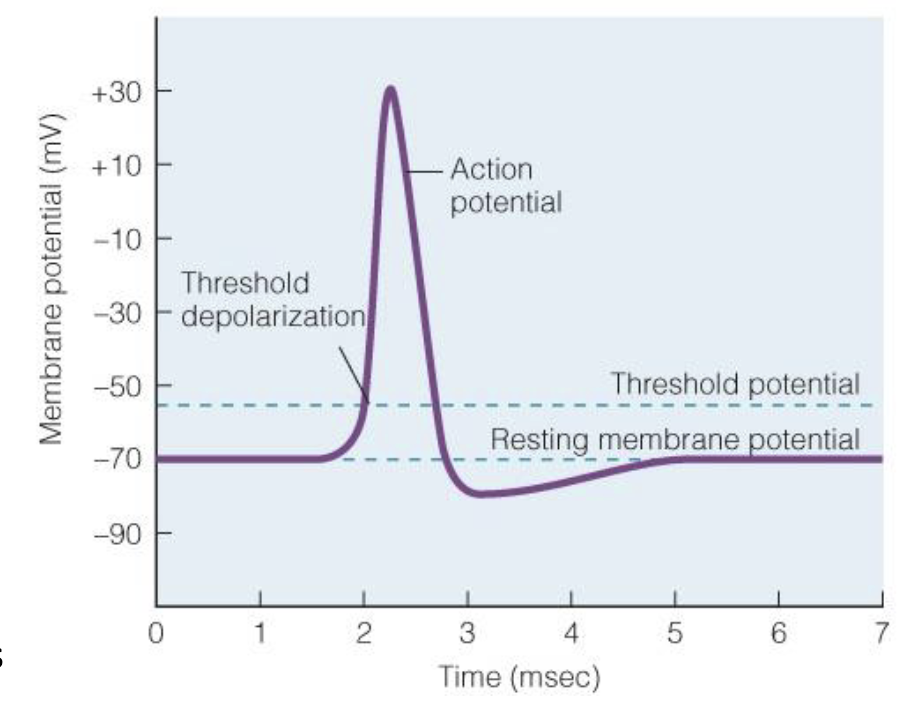
electrotonic spread
the spread of electrical activity through cells or living tissue - graded potentials spread in all directions
Graded potential mechanism
neurotransmitter binds to a ligand-gated Na+ channel > Na+ entes cell thru the open channel > current spreads through the cell > strength of signal decreases with distance
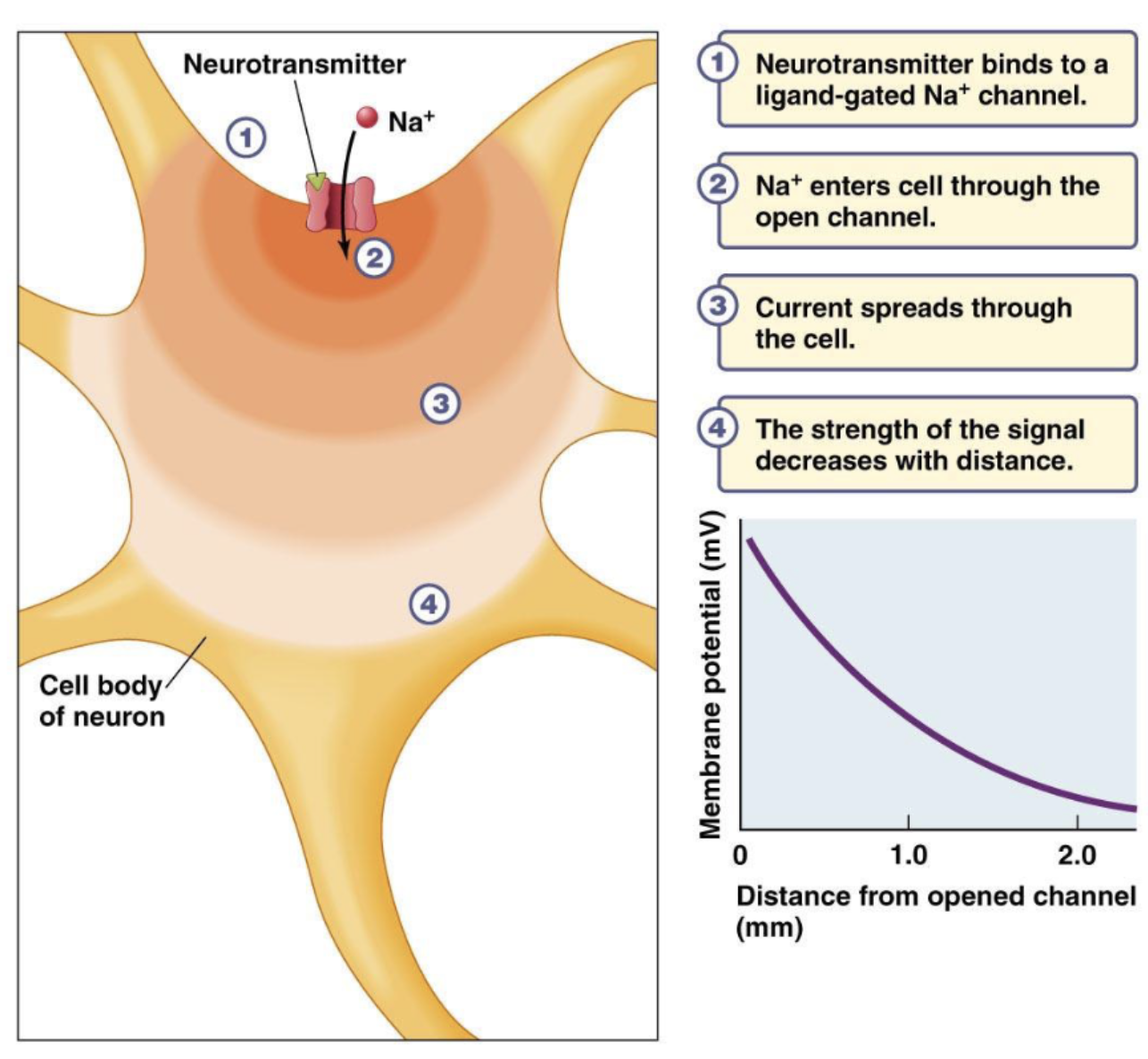
Length constant
the distance that electrotonic current can spread along the membrane
distance to dec. to 37% of the original value
graded potetial signal strength depends on / is proportional to
ligand concentration: more ligands —> more ion channels open —> more/higher change in membrane potential
AND
Distance
Threshold potential
membrane potential required to initiate an action potential
around -55 mV
What is the final trigger for action potential
at axon hillock, stimulus must surpass threshold for AC
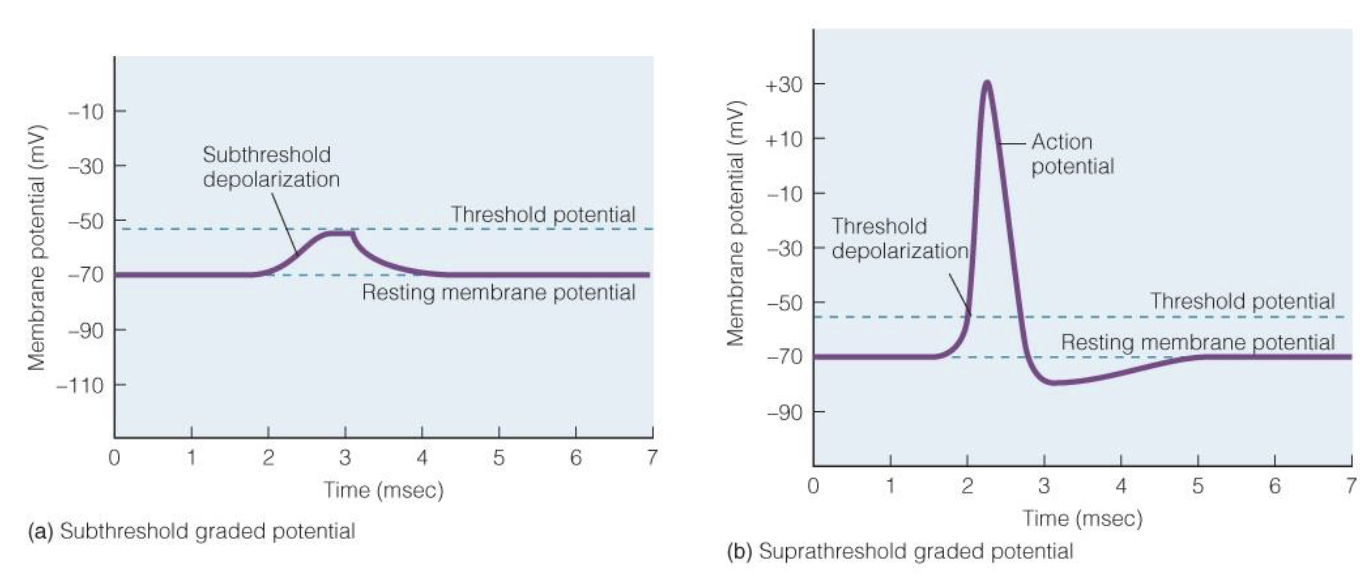
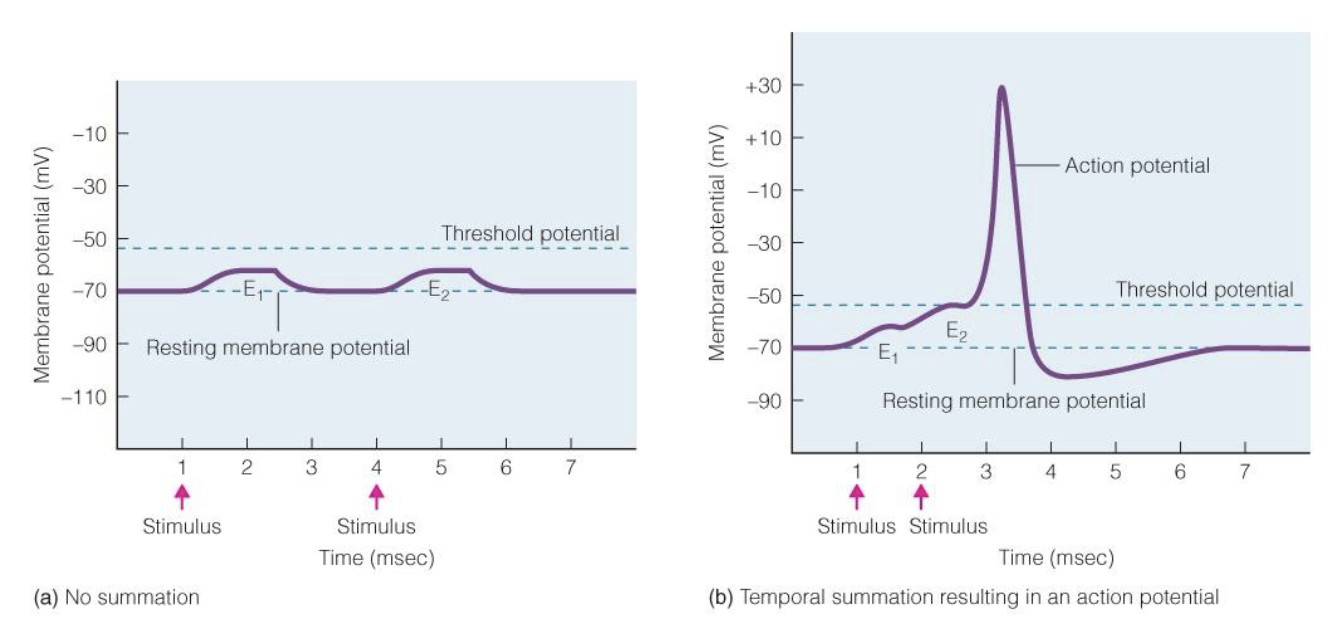
Integration of graded potentials occurs in
space in time
temporal summation and spatial summation
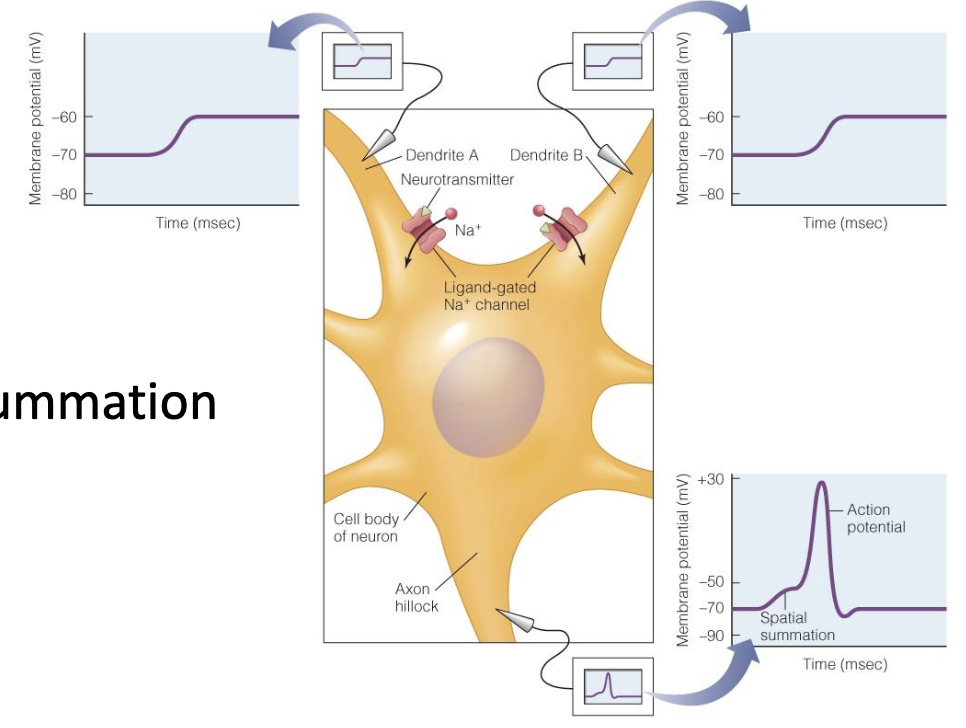
Graded potentials can cause _____ or _____ through what potential types
depolarization (excitatory post-synaptic potential)
hyperpolarization (inhibitory post-synaptic potential)
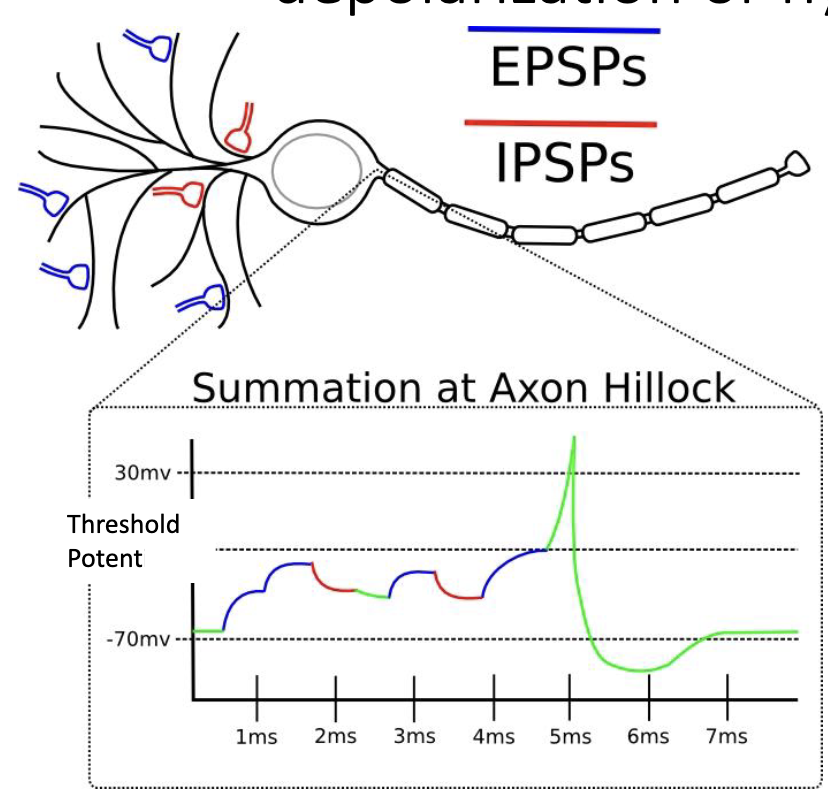
Components of Voltage-gated Na+ channels
activation gate and inactivation gate
activation gate
voltage sensor and opens at threshold
inactivation gate
closes from cytoplasmic side
Voltage-gated Na+ channels display
intrinsic inactivation
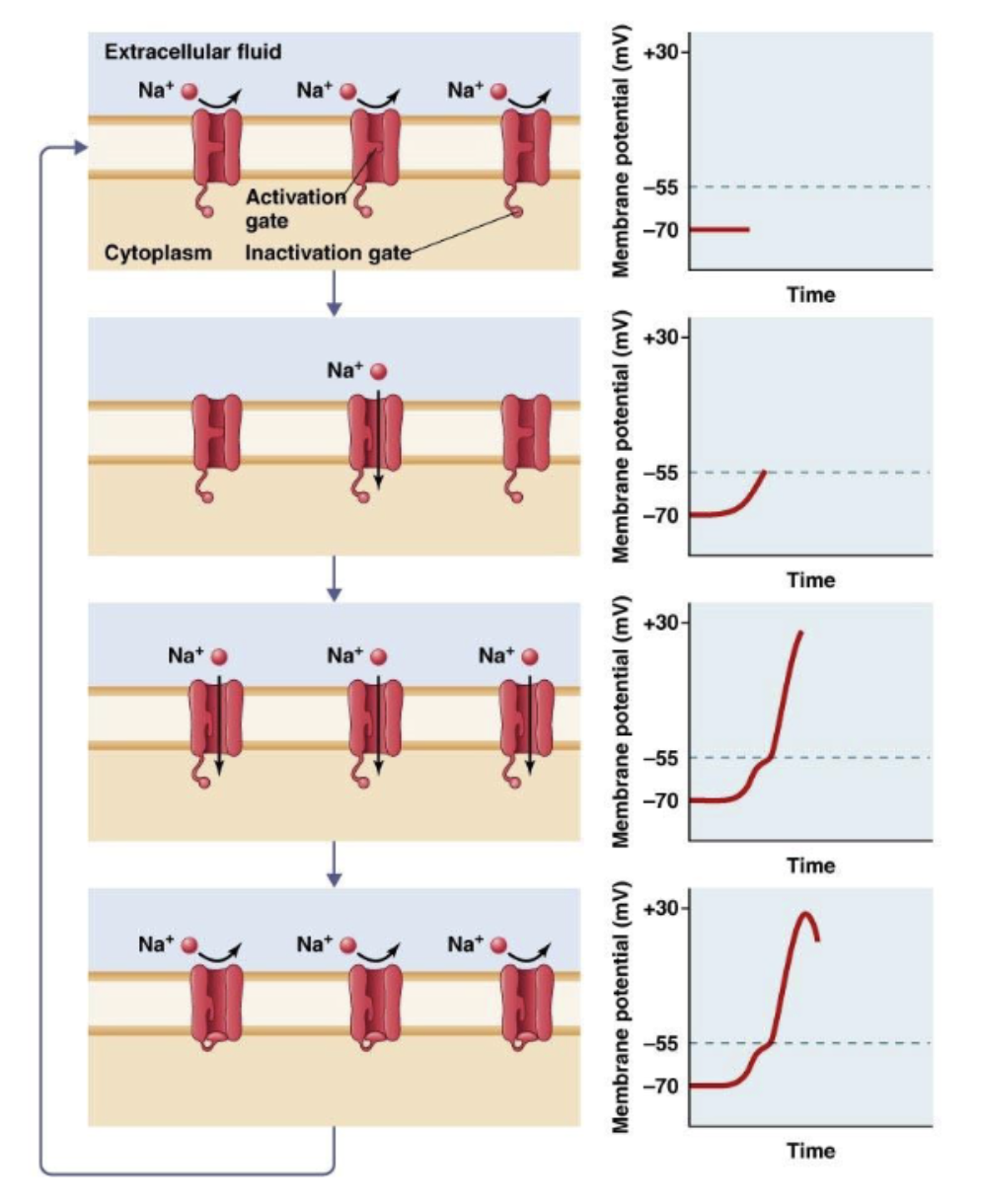
intrinsic inactivation
a property of certain ion channels that closes the conduction pathway when the membrane depolarizes
Depolarization of the membrane causes
intrinsic inactivation - inactivation gate closes in voltage-gated Na+ channel
AND
activates voltage-gated K+ channels
The differing _____ of the voltage gated Na+ and K+ channels account for the ____ of the action potential
kinetics; shape
Parts of action potential
resting membrane potential (produced by Na+/K+ pumps and maintained by leaky channels) —> summation (either spatial or temporal) - graded potentials due to some stimuli (neurotransmitter) —> threshold reached (voltage-gated Na+ channels open both inactivation and activation gates open) —> depolarization —> before top voltage reached, K+ channels opens then Na+ channels close (inactivation gate) (both are open at same time for a short period) —> top voltage reached —> repolarization (inactivation gate is closed of Na+ voltage gated channel and K+ voltage-gated channel is open)—> inactivation gate opens after absolute refractory period and K+ still open (relative refractory period) —> afterhyperpolarization (return to resting membrane potential due to Na+/K+ pumps and Na+ and K+ leaky channels)
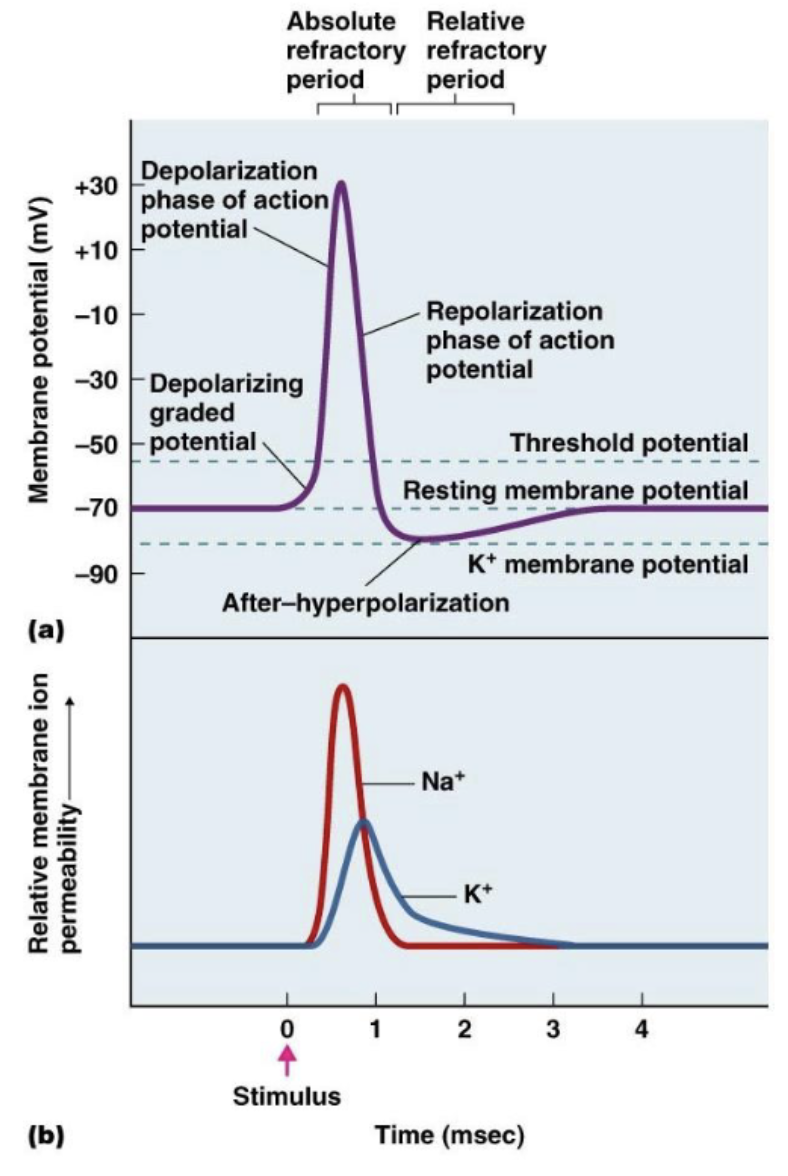
summation
the process by which multiple electrical impulses at the synapse and axon hillock are added together to determine whether an action potential is generated
either spatial or temporal
caused by graded potentials due to some stimuli
voltage gated K+ channels (how they work)
when membrane potential (inside/cytosol) becomes more pos. —> repels pos. charges in the K+ protein channel —> opens channel up b/c pos. charges move and the protein channel changes conformation
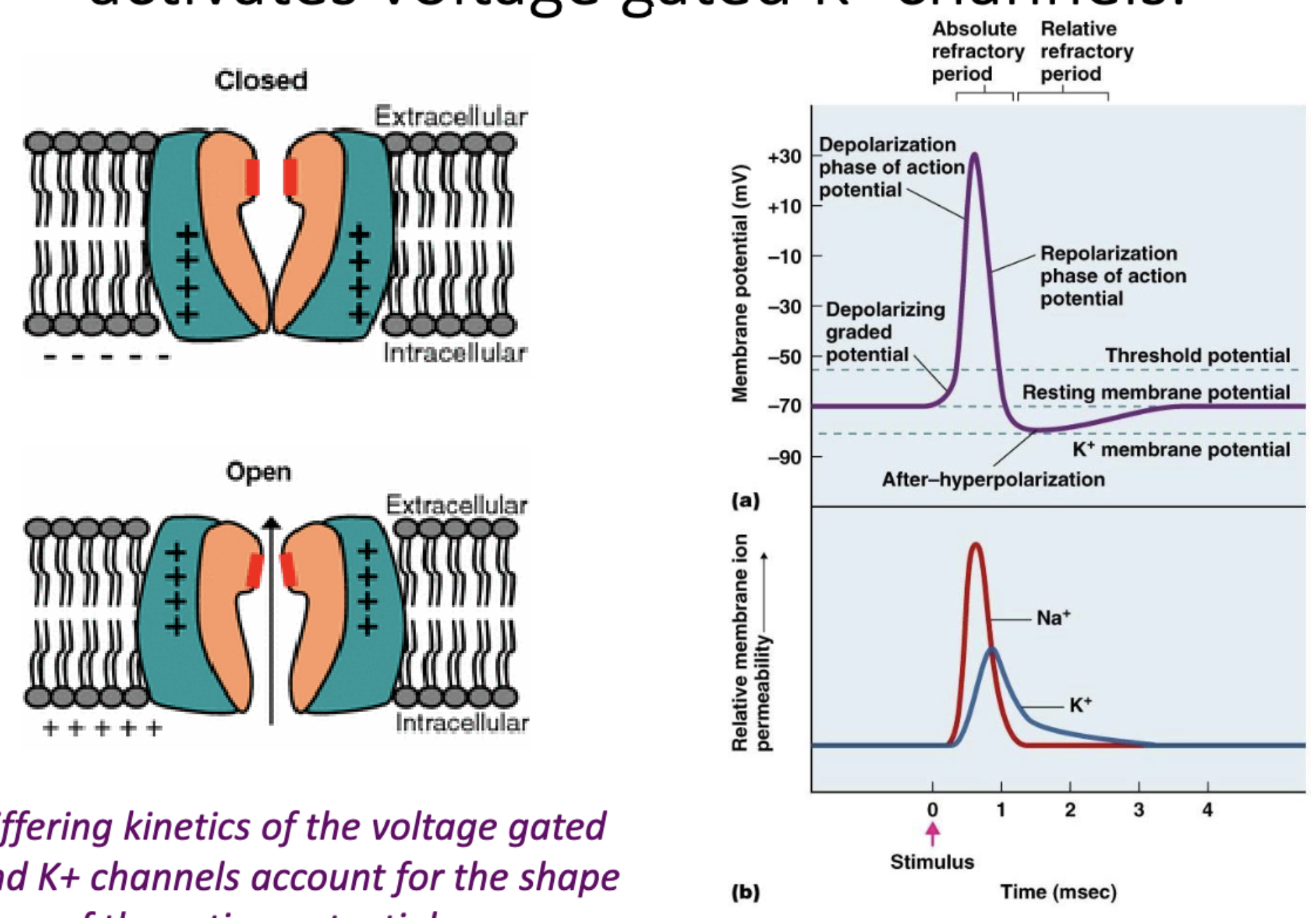
Action potential refractory periods
absolute refractory period and relative refractory period
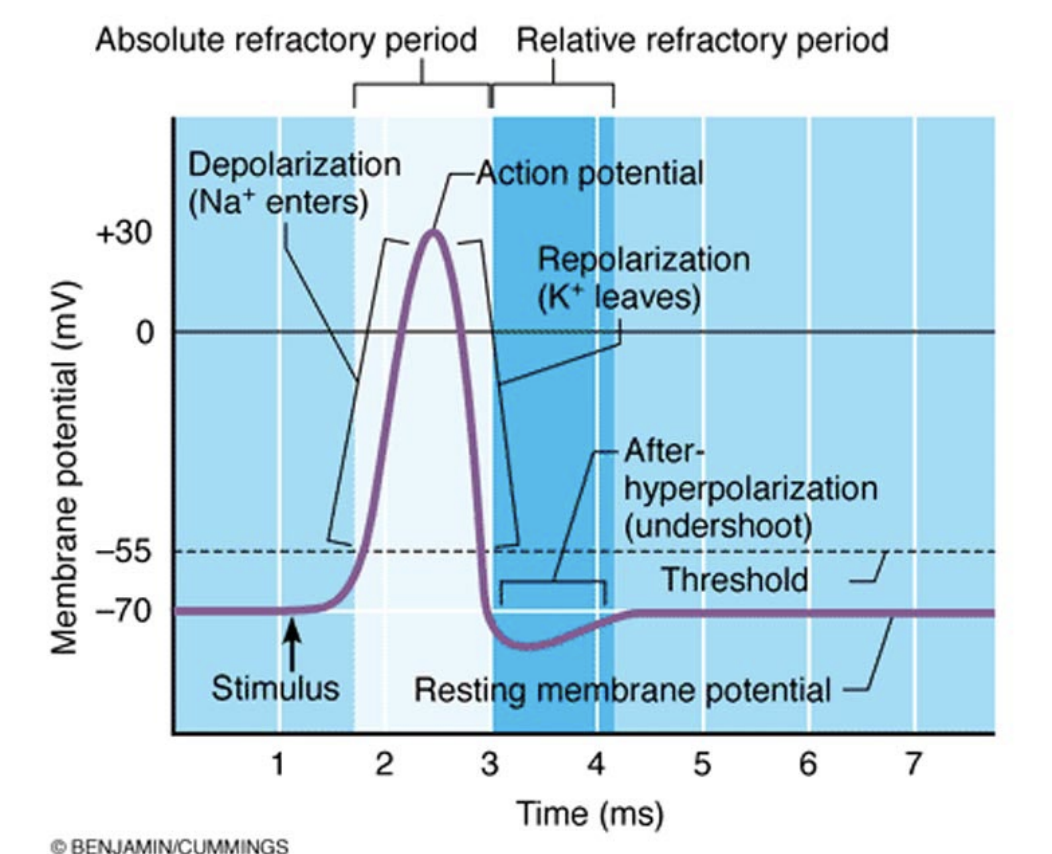
Absolute refractory period
Starts at the initiation of AP until the end of the Na+ channel inactivation - the time during which another AP cannot be triggered
inactivation gate closes before the top voltage
relative refractory period
Start of afterhyperpolarization to restored resting membrane potential - time during which a much stronger stimulus is required to trigger an AP
due to hyperpolarization, a large current is required to reach threshold
Na+ channels are ready to depolarize but K+ are still open
APs move down the ____ ____ _____ over a long distance
axon rapidly over
When _____ flows into the neuron, it flows ______ in both ______
current; passively; direction
When _____ ___ flow into the neuron, ____ ____ flows passively in both ______ (bidirectional flow)
Na+ ions; positive current; directions
______ ___ of voltage-gated ___ channels ensures unidirectional APs
Inactivation gate; Na+

Action potentials display typical ____ and ____
durations; amplitudes
Stimulus strength is encoded by
AP frequency
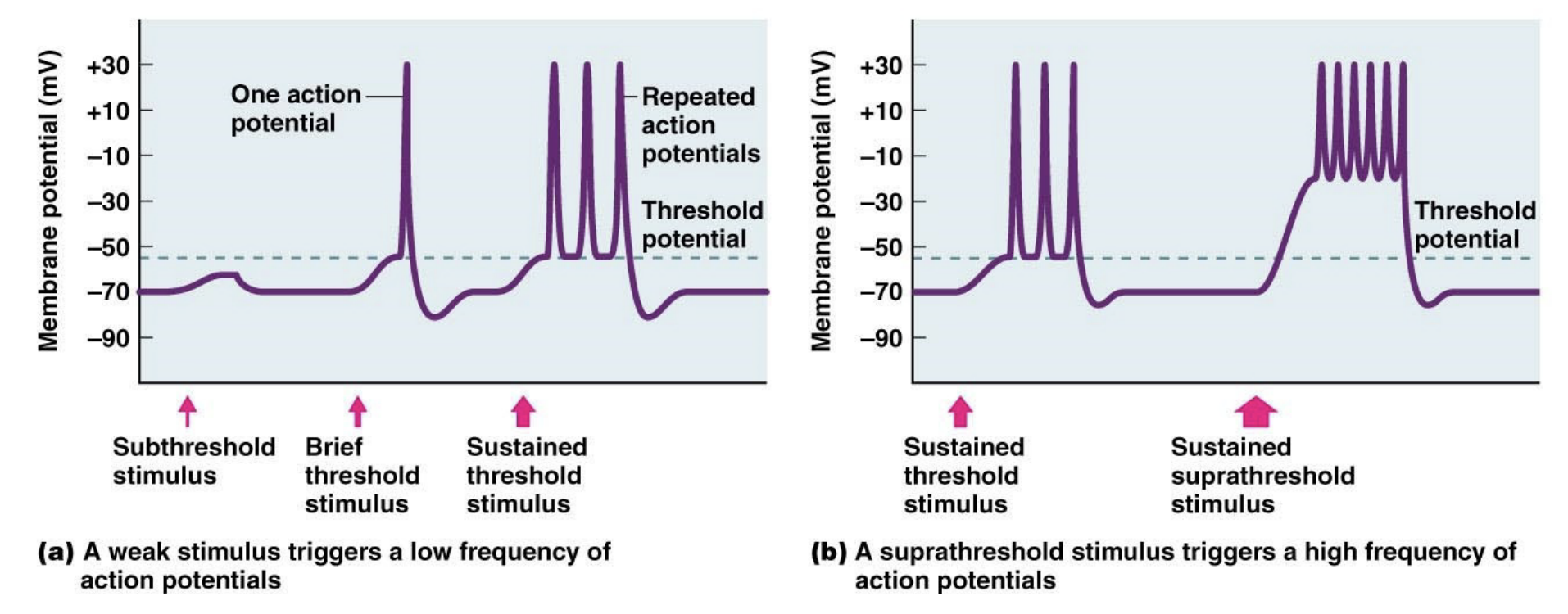
What is necessary for high frequency APs
strong, sustained depolarization
Different types of stimulus (in regards to AP frequency)
subthreshold stimulus; brief threshold stimulus; sustained threshold stimulus; sustained suprathreshold stimulus
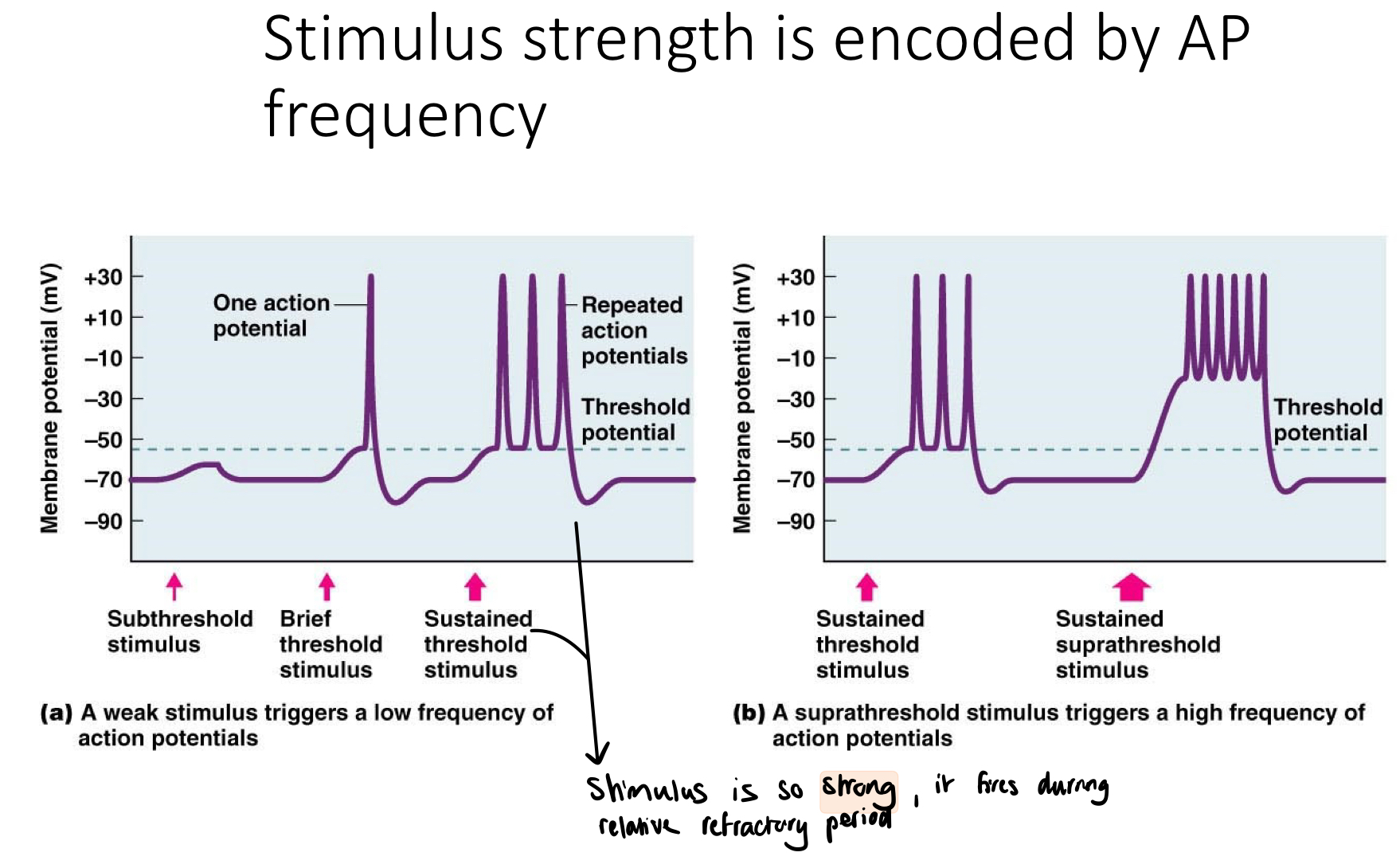
APs spread from the
axon hillock to the axon terminal
How do neurons transmit their signals to other cells
electrical synapses or chemical synapses

chemical synapse (basic)
synaptic vesicles release neurotransmitter by exocytosis
Chemical Synapse mechanism
Voltage-gated Ca2+ channels open in response to AP induced depolarization —> increased intracellular Ca2+ facilitates neurotransmitter release (snare protein aka docking protein moves vesicles w/ neurotransmitters to synaptic side of neuron and vesicles fuses w/ membrane to release neurotransmitter via exocytosis)
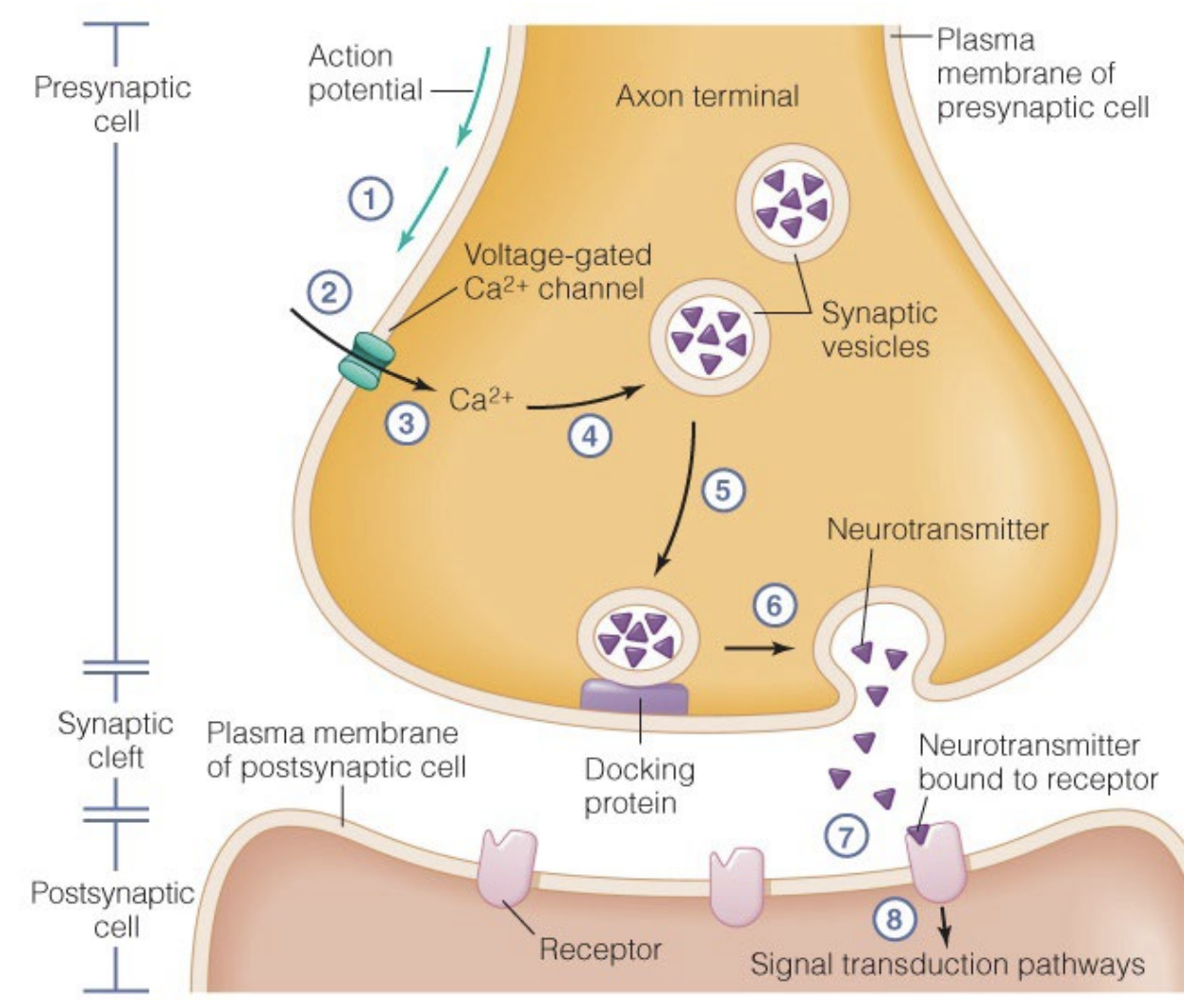
Neurotransmitter
synthesized in neuron
released at presynapse following depolarization
bind and cause effect at post-synapse
There is a great diversity of ______ and _____
neurotransmitters; receptors
neurotransmitters
Amines:
acetylcholine
amino acids: glycine, asparate, glutamate
biogenic amines: dopamine, norepinephrine, epinephrine
Peptides
endorphins
neuropeptide Y
Other
Gas: nitric oxide
Nucleic acid: adenosine
A ____ ____ can have very different effects on _____ target cells
single neurotransmitter; different
Different ______ to the same transmitter can have ______ ____ on _____ neurons
receptors; opposite effects; target
Classification of receptors
ionotropic or metabotropic
Ionotropic receptor pathway
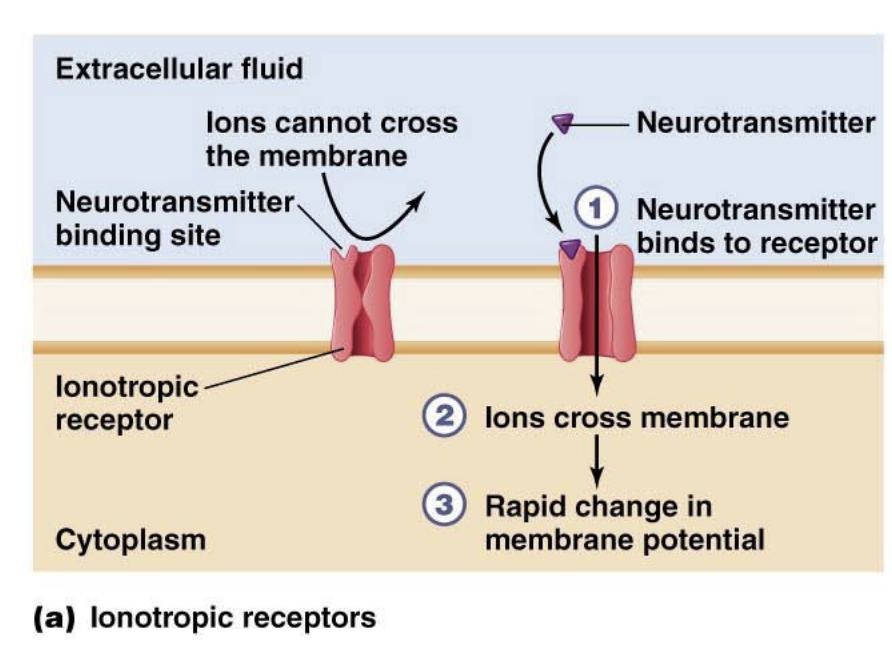
Metabotropic receptor pathway
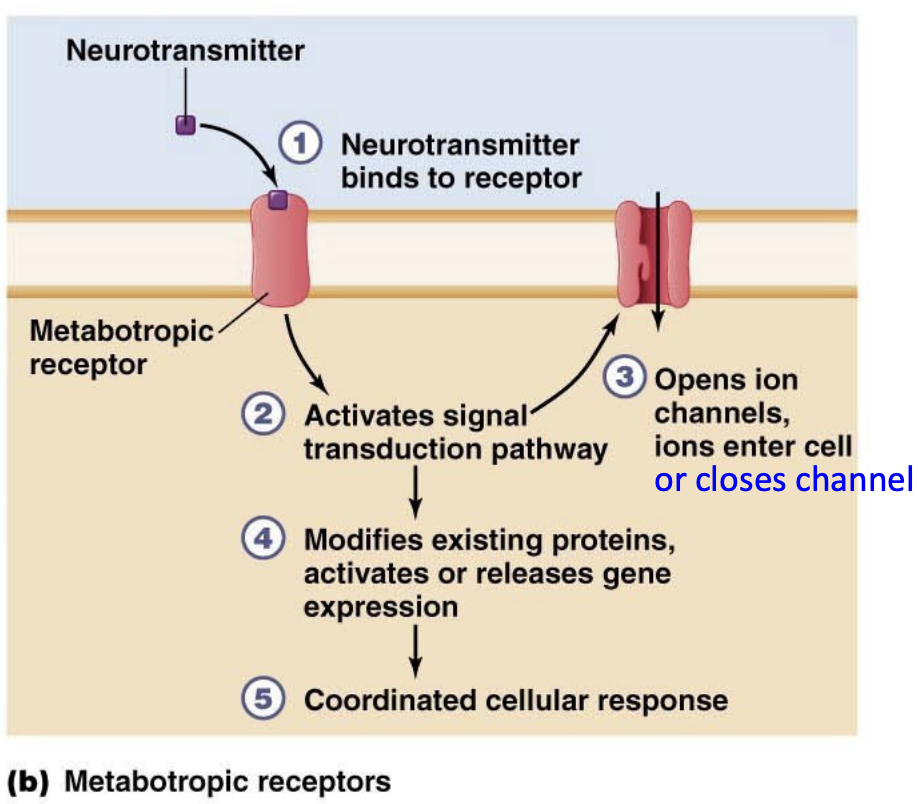
Graded potentials are faster or slower than APs
faster
Synthesis of Acetylcholine as a neurotransmitter

Acetylcholine (Cholingeric) receptor subtypes
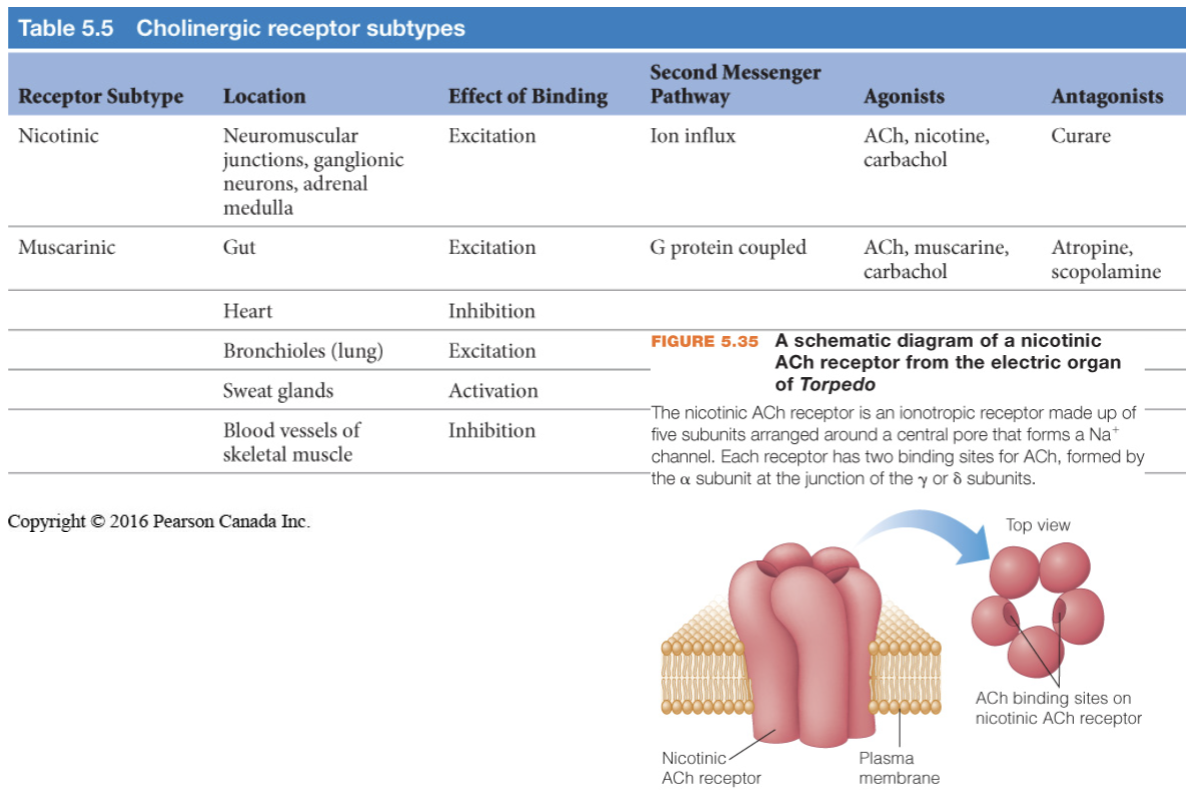
Norepinephrine differing responses due to
Binds to several diff. receptor types
alpha-1 adrenergic receptor
alpha-2 adrenergic receptor
beta-1 adrenergic receptor
beta-2 adrenergic receptor
Alpha-1 adrenergic receptor
excitation - cause vasoconstriction in smooth muscles of blood vessels
location: skin, GI system, kidney (renal artery), salivary glands, NOT bronchioles
GPCR > PLC > PKC > calcium channels
NE > E
Alpha-2 adrenergic receptor
Inhibitation - inactivates calcium channels and reduce release of NE
location: presynaptic nerve terminals, platelets, and fat cells
dec.s neurotransmitters and insulin and inc.s glucagon
NE = E
Beta-1 adrengeric receptor
Excitation - activate calcium channels and increase muscle contraction
location: cardiac muscle
inc.s contraction and HR and renin
GPCR > AC > PKA > activates Ca2+ channels
(NE = E) > alpha
Beta-2 adrengeric receptor
Relaxation reduces muscle contraction and casues vasodilation
Location: vascular smooth muscle, bronchioles, and GI
(E>>NE) > alpha
alpha-1 adrenergic receptor mechanism
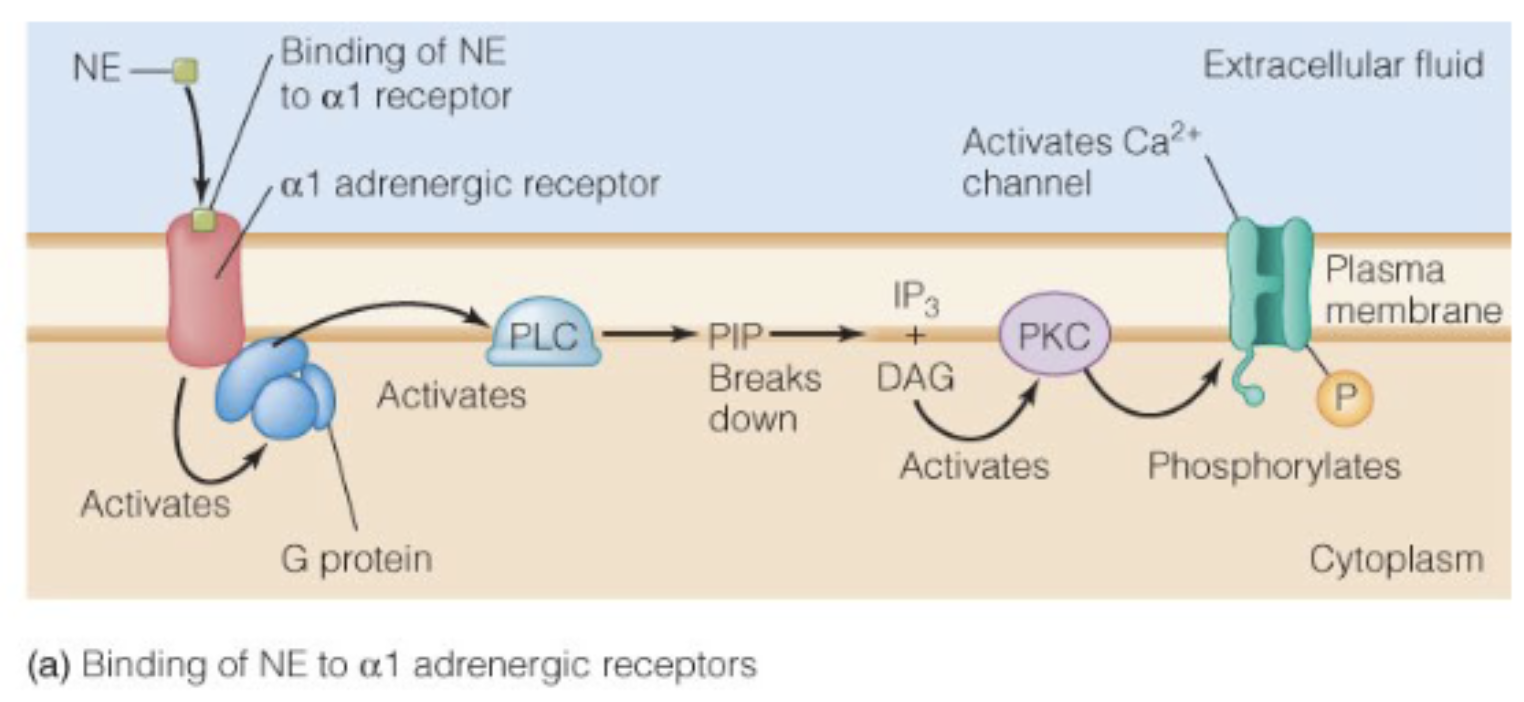
alpha-2 adrenergic receptor mechanism
AC: adenylate cyclase
PKA: protein kinase A
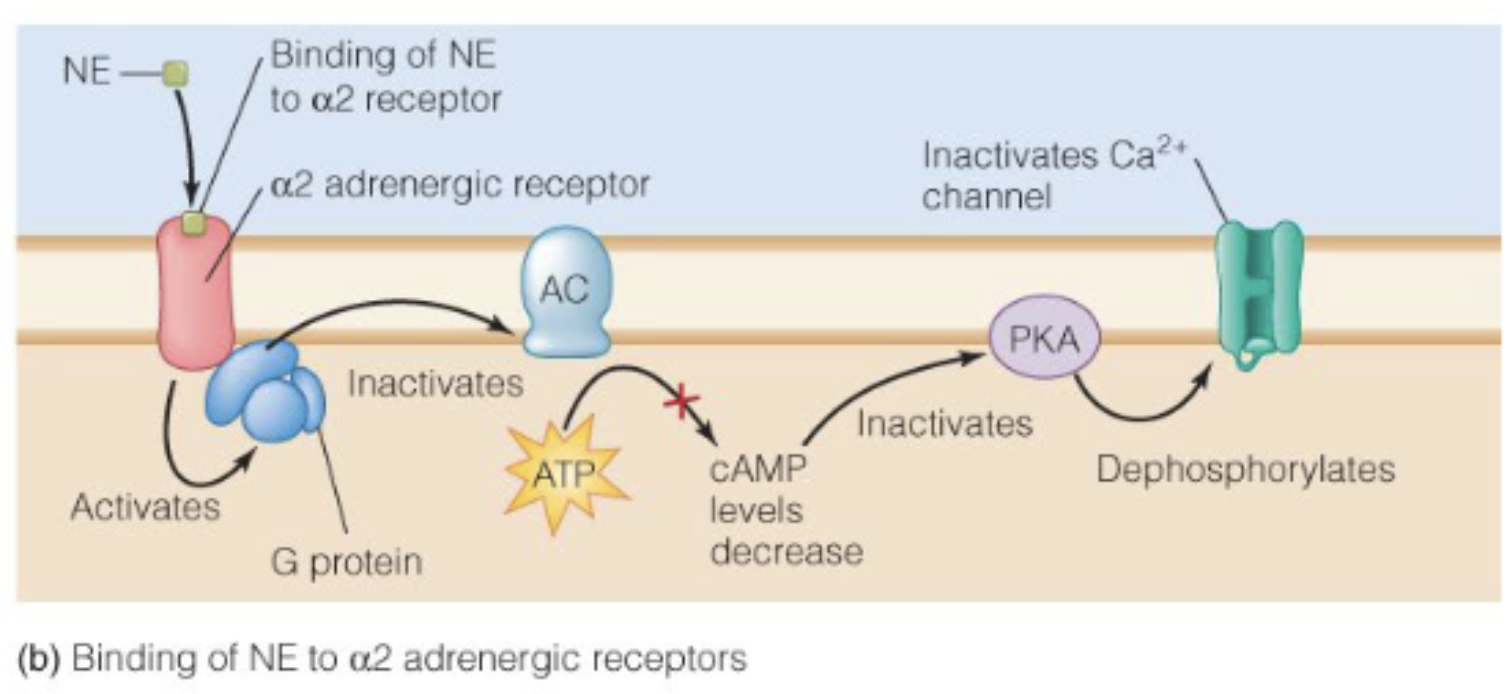
Beta-1 adrenergic receptor mechanism
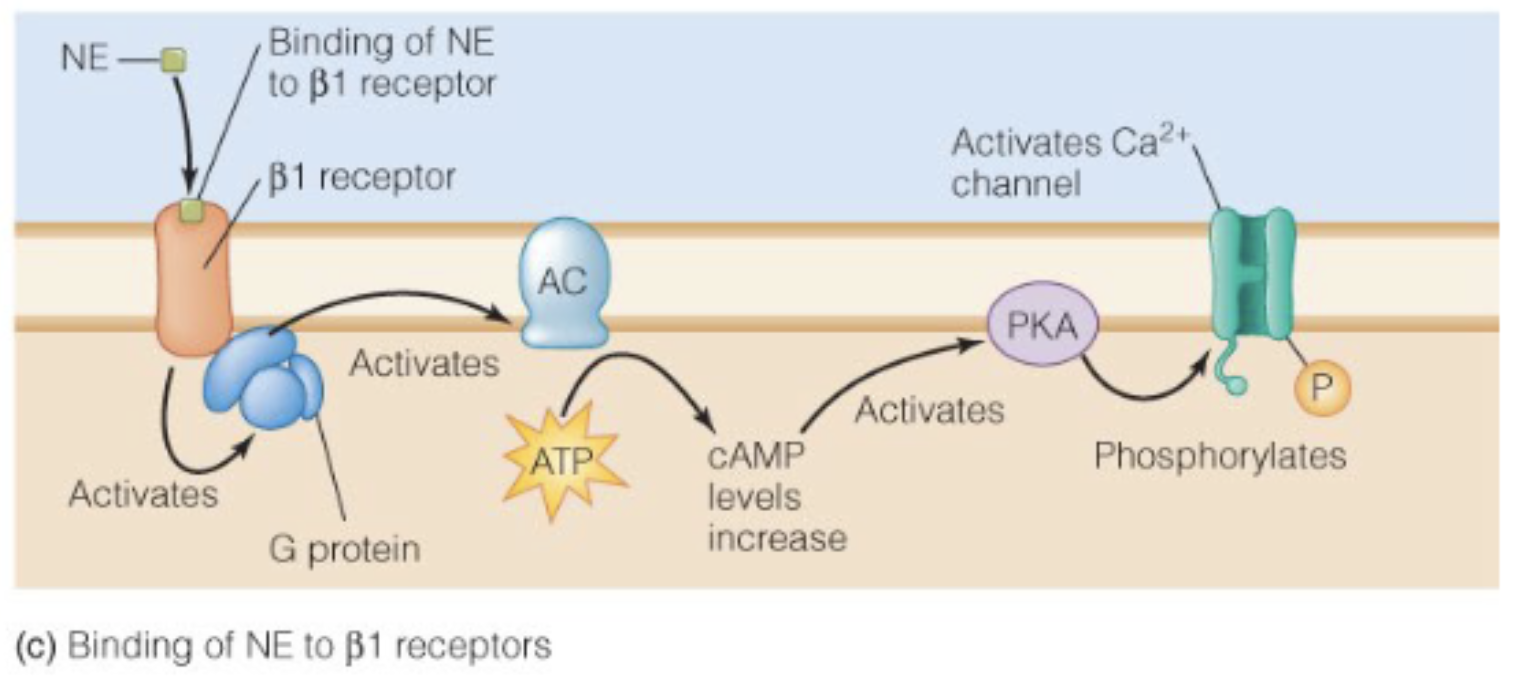
Beta-2 adrenergic receptor mechanism
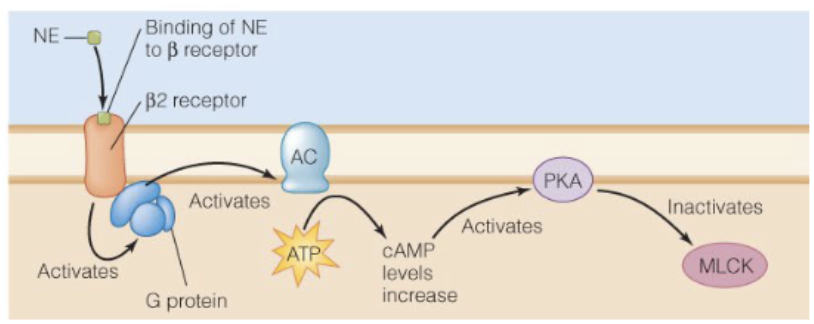
Differing effect of NE
Cause pupil dilaiton
Cause stronger heart contraction
Inc. none-shivering thermogenesis in brown adipose tissue
constrict arteries - inc.d BP
Cause release of renin and Na+ in kidneys
Inc. glycogenolysis (inc. BGL)
Inc. release of glucagon (inc. BGL)
Inc. glucose uptake in skeletal muscles
Inc. lipolysis
Reduce digestive activity in digestive system
Structural diversity of neurons occurs ____ and ___ ____
within; across species
structural classes of neurons
multipolar neuron; bipolar neuron; and unipolar neuron
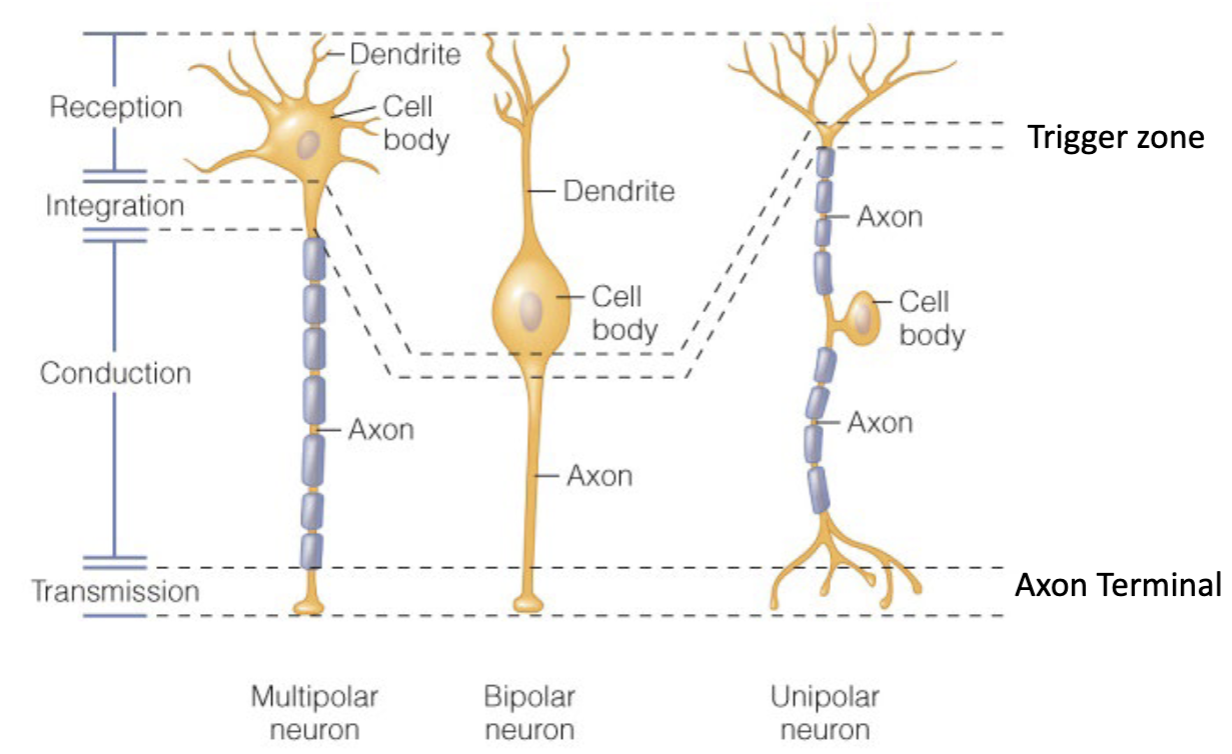
Funcional classes of neurons
sensory (afferent) neurons; interneurons; and motor (efferent) neurons
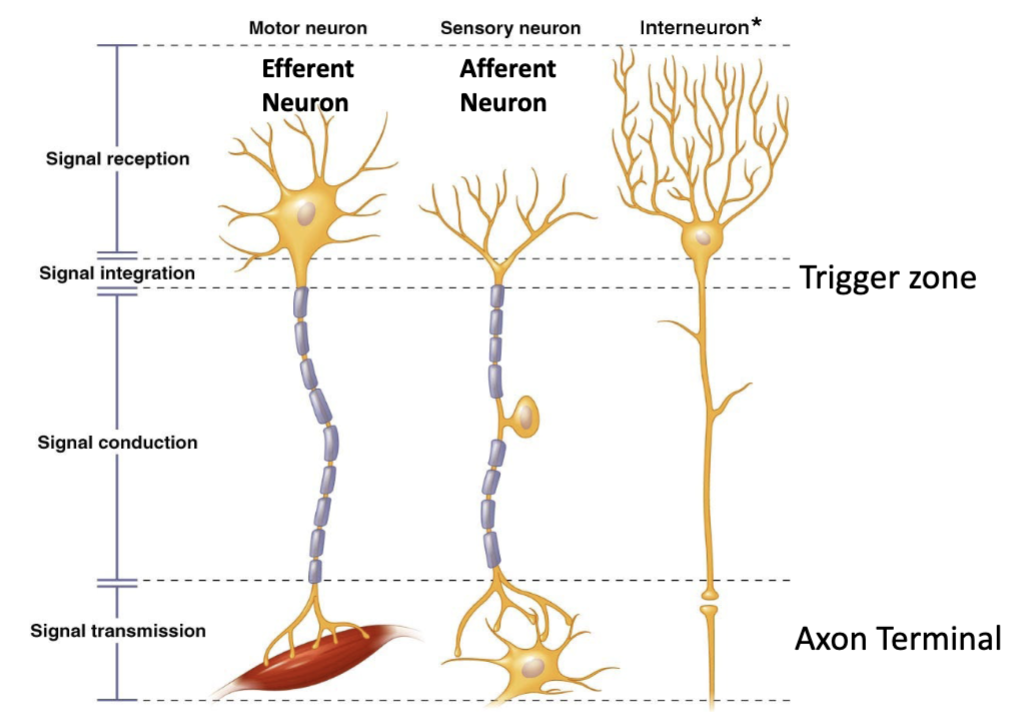
Afferent neurons
considered unipolar neurons
trigger zone is at the interface b/w the dendrites and the axon
carry impulses from the periphery to CNS
Interneuron
connect one neuron to another
typically multipolar and may have multiple axon terminals
varying functional class
many dendrites
Efferent neuron
carry signal from CNS to some external target organ (muscle, glands, and other tissues) which are stimulated
generally multipolar
elicits a response in the effector organ
______ increases the speed of AP ______ down the _____
myelination; conduction; axon
AP generation is slower than _______ _____
electrotonic spread
electrotonic current ______ with distance, while APs maintain _____
decreases; amplitude
Myelin sheath
insulates regions of the axon
restricts APs to nodes of Ranvier
Forces electrotonic spread through internodes
Best compromise b/w APs and electronic spread [uses both graded (speed it up) and action potentials (reestablish high amplitude)]
![<p>insulates regions of the axon</p><p>restricts APs to nodes of Ranvier</p><p>Forces electrotonic spread through internodes</p><p>Best compromise b/w APs and electronic spread [uses both graded (speed it up) and action potentials (reestablish high amplitude)]</p>](https://knowt-user-attachments.s3.amazonaws.com/d46b4885-7f4b-403a-a8e7-a38629e64d19.png)